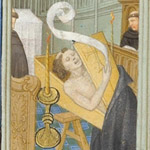 |
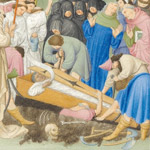 |
 |
Above: Details of illuminations from Folio 94v, Folio 95r, and Folio 96v from the Belles Heures of Jean de France, duc de Berry, 1405–1408/9. Herman, Paul, and Jean de Limbourg (Franco-Netherlandish, active in France by 1399–1416). French; Made in Paris. Ink, tempera, and gold leaf on vellum; 9 3/8 x 6 5/8 in. (23.8 x 16.8 cm). The Metropolitan Museum of Art, New York, The Cloisters Collection, 1954 (54.1.1).
A self-contained quire of two bifolia inserts another novel picture cycle between traditional sections, and we get to enjoy another display of the Limbourg brothers’ genius. This story is taken from a thirteenth-century Life of Saint Bruno, and like the other added sections, the text is reduced to four lines per page in alternating red and blue ink. It recounts the legend around Saint Bruno’s foundation of the Carthusian order, a reformist monastic sect that allowed individual monks to live as hermits but with some communal elements. Jean de Berry’s brother Philip the Bold, Duke of Burgundy, was a major patron of the Carthusian Order and built its famous monument, the Chartreuse de Champmol in Dijon. (Incidentally, the Chartreuse in Dijon is also where John the Fearless—Philip’s son and Jean de Berry’s nephew—was buried. His tomb featured the carved alabaster figures of mourners now on view at the Met in the special exhibition The Mourners: Tomb Sculpture from the Court of Burgundy.)
One of the enduring achievements of the Limbourg brothers is their expressive rendering of human emotion, and the story of Saint Bruno—which had never before been represented in art—demonstrates this perfectly. The cycle begins with a scene of the great scholar Diocrès, who was a professor of the University of Paris, working on a scroll at his desk while surrounded by other scholars (Folio 94r). The next two pages (Folio 94v and Folio 95r) depict the drama of what happens next: the deceased scholar calls out from his coffin, first inside a monumental church and again, the next day, in a cemetery. He says, “I have been accused in the fair judgment of God!” In Folio 94v, we see the monks in the choir stall reacting with shock. Each of them has a different gesture of alarm and aversion, reacting not just with his face but with his whole body. Similarly, in the scene at the cemetery (Folio 95r), the clerics at the right react to the corpse crying out again. The man in blue raises his hands heavenward and leans back so far that his face is foreshortened. This may even be Bruno, whose dismay at this miracle led him to seek a hermetic life. He gained permission from his bishop to found a new order, the Carthusians, and built the first Charterhouse in the mountains near Grenoble.
Even where there is no special emotional charge, the artists demonstrate skill with story telling. The scholarly gathering that opens the narrative is a busy hive of writing and discussing (Folio 94r).
Illumination from Folio 94r
In Folio 95v, we see Saint Bruno gesturing to his companions as they follow him out of Paris, toward their destiny as hermit monks in the hills and ultimately toward the portal of their future monastery in the mountains.
Illumination from Folio 95v
The dream vision of the sleeping bishop shown in Folio 96r—how many bishops sleep in their miter?—is embodied in the seven stars, which foretell the arrival of Bruno and his followers.
Illumination from Folio 96r
Finally, the monks in white entering their new foundation (Folio 97r) are so clearly depicted in the several stages of moving into the building, from pulling on the cowl to bowing in reverence while entering.
Illumination from Folio 97r
The final scene in the cycle (Folio 97v) is totally different, more like the final scene in the Catherine cycle (Folio 20r) than anything else in the manuscript. It is a bird’s-eye view that includes a portrait of the monks’ new building, the Grande Chartreuse, set in the mountainous landscape near Grenoble. Although not in correct perspective, the illustration is convincing because it shows key facts about the structure that relate to the special nature of Carthusian monasticism. The large chapel can encompass group worship, as in the cenobitic (communal-life) monastic tradition of Saint Benedict, while the individual cells seen above the cloister preserve the hermetic isolation of the desert fathers and other hermit monks. This grand and beautiful building is set in this wild landscape (but with a foliate background instead of sky), while in the foreground monks are busily engaged in fishing.
Illumination from Folio 97v
While leading a tour a few days ago, I was asked whether there is evidence of underdrawing in the Belles Heures, and I know it is a question of interest to many. The answer is yes, and the Bruno section of the manuscript includes an example that can be seen even without special scientific instrumentation. On Folio 96r, a faint sketch is visible on the red wall above the head of Bishop Hugo, who is shown sleeping under his big, cozy, red blanket.
Detail of illumination from Folio 96r
Close inspection reveals it to be a small altarpiece or shrine with an image of the crucifixion, for private devotions within the cell. Even though it was never painted in, this drawing alerts us to the general practice of making preliminary sketches on the parchment. Most of these sketches would have been obscured by the final painting; in this case, the sketch never made it into the final version. It is likely that all elements of the miniatures were planned and sketched before their final execution.
The Office of the Dead
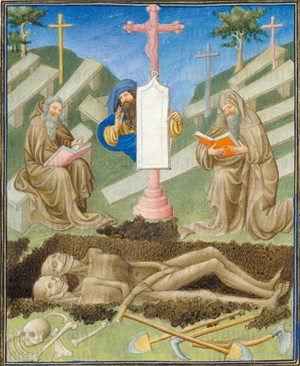
Illumination from Folio 99r
This important text is found in most standard books of hours, and fills three full quires in the Belles Heures, yet it is marked by only one illumination, an enigmatic cemetery scene (Folio 99r). The Office of the Dead was considered essential because the recitation of its prayers was said to shorten the time spent in purgatory by one’s deceased loved ones. Most books of hours only have one miniature for this section, but there is more variation in the choice of scene than in all other traditional texts. Typical choices include a funeral in a church, a deathbed vignette, funeral processions, burials, souls in purgatory, and many others. In the Belles Heures, there is an open grave with not one but two bodies, not recently deceased but partly decomposed. The workmen’s digging tools are scattered in the foreground along with other skeletal remains. Two monks or hermits pray from large, colorful books while a third figure, probably a prophet, peers from behind a column topped with a cross, and points at a blank placard. What is this scene in a graveyard? Who are these figures? What should be written on that white tablet? There is a possibility that the two decomposed bodies can be explained as reference to the scene and story known as the “three living and the three dead,” in which two of the three corpses are shown decomposed (see example). However mysterious it appears, this scene was later copied in another book of hours (Paris, Bibliothèque nationale de France, ms Lat. 1156A, fol. 114.) that belonged to another relative of Jean de Berry. In the later version, the crucifix was moved down from the top of the column to where the blank placard is here. The image is published in Meiss (illustration 158 of the Boucicaut Master volume), but unfortunately I haven’t been able to find it online to include here.
—Wendy A. Stein
Related Essay: “Art and Death in the Middle Ages”
Tags: Bishop Hugo, Bruno, Carthusian, Chartreuse de Champmol, Dijon, Diocrès, hermit, John the Fearless, Philip the Bold, The Office of the Dead



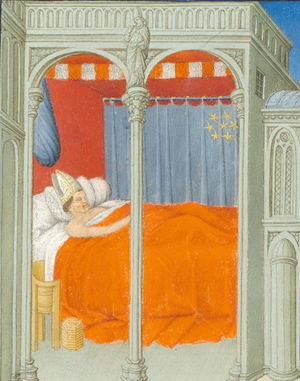
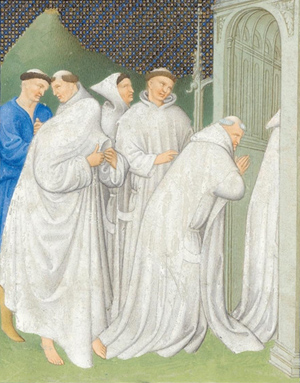
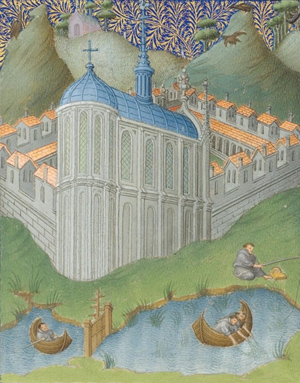
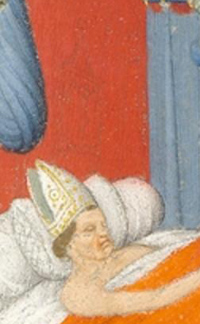
April 14, 2010 at 11:02 AM
[...] Read the original: Saint Bruno and the Founding of the Carthusian Order | The Art of … [...]
April 14, 2010 at 3:44 PM
For those interested in the Carthusian order and the Grande Chartreuse, I recommend the 2005 film Into Great Silence (Die Grosse Stille), which is available on DVD.
April 14, 2010 at 5:29 PM
Dear Peter,
Thank you so much for reminding us all of this extraordinary film! I have heard of its power from those who have seen it, and have been assured of the way it allows viewers to enter into the reality of Carthusian monastic life.
Best,
Wendy
May 25, 2010 at 5:30 PM
Hi – my husband and I spent the entire morning this past Sunday, and then several hours again after lunch, enjoying this spectacular exhibit. I seem to remember a reference to Virgil’s 4th Eclogue during this section – I meant to write it down but did not. Could I trouble you to remind me which image was referenced to the Virgil? Thanks again – this is a fabulous blog
May 26, 2010 at 3:53 PM
Dear Marni,
Glad you liked the show and blog. The reference to Virgil is on the label for John the Baptist in the wilderness, Folio 211r. It relates to a theory about the identity of one of the mystery figures flanking John.
Wendy